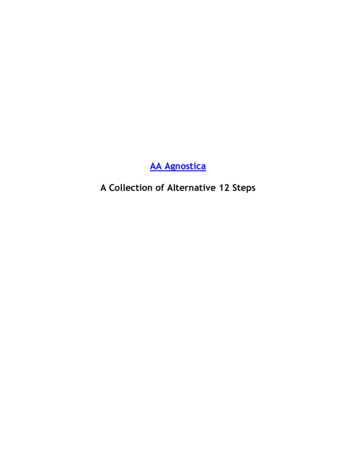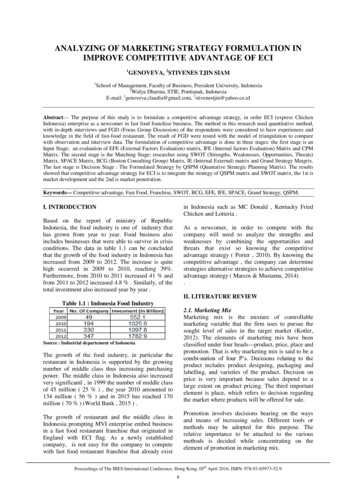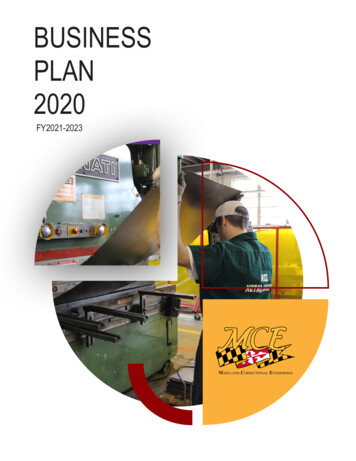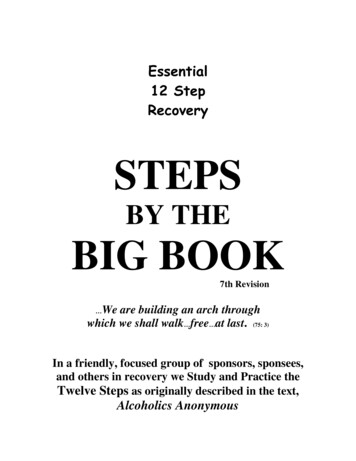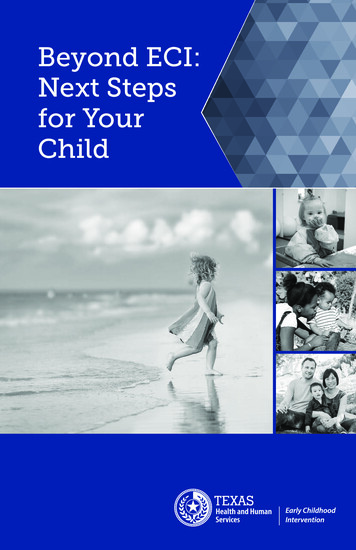
Transcription
Beyond ECI:Next Stepsfor YourChild
This ECI transition book belongs to:Your Child’s NameWhat is in this book?Choices for your child after ECI.2Questions to help you decide.3Choices for your child in your community. 4–5Choices for your child in the local school district. 6–9Terms you may hear during transition.10–11Ways your service coordinator can help. 12Further information. 12Checklists. 13ECI Program InformationProgram NameProgram DirectorTelephoneECI Service CoordinatorTelephoneWebsite: hhs.texas.gov/eciTalk to your local ECI program if you need more information orhave a concern about your services. If you still have concernsor need more information, call the Office of the Ombudsmanat 877-787-8999. For persons who are deaf or hard of hearing,please use the relay option of your choice.
While your child has been in Early Childhood Intervention(ECI), you and your ECI team have developed outcomes andactivities to help your child grow and learn, addressed yourchild’s health needs, and addressed the needs of your family.Now that your child is getting older, it is time to start planningfor when he or she leaves ECI.All children must exit ECI by their third birthday. We callthe process of exiting out of ECI “transition.” Successfultransitions require planning ahead with your ECI team andother partners, such as community service providers. Your ECIteam will work with you to develop steps and services fortransition that are specific to your child and family when yourchild is between 27 months old and no later than 90 daysbefore your child’s third birthday. Your ECI team will assist youin finding resources for your child and family for when yourchild is no longer enrolled in ECI.Beyond ECI: Next Steps for Your Child1
CHOICESfor your CHILD after ECIThere are many options for your child after he orshe exits from ECI. You and your ECI team candetermine what choices will be best. Your servicecoordinator will help you determine what mightbe needed for your child to participate in any ofthe following. Child care settings Private therapy Charter schools Head Start Parent’s Day Out programs Community recreation programs Neighborhood play groups Library story hours Classes for children, such as art,music, gymnastics or swimming School district Preschool Programsfor Children with Disabilities(PPCD)2Beyond ECI: Next Steps for Your Child
QUESTIONSto help you decideWhat does my child like to do?How do I want my child to interact with others?What are my goals for my child in the next year?Beyond ECI: Next Steps for Your Child3
CHOICESfor your CHILD in yourCOMMUNITYYour service coordinator will help you explore options andschedule transition meetings with the organizations or programs in your community that you might like your child toattend after he or she exits from ECI. Your service coordinator and other team members can also provide strategies to helpyour child fully participate in these programs and activities.Attending a transition meeting does not mean your child has toenroll in the program you are considering. These meetings willgive you a chance to learn more about the services offered, findout about next steps and ask questions.Remember, transition is a time to look at all of your child’s options. Your child can enroll in both community programs andactivities, and enroll in the school district PPCD. If you areconsidering several options, you may have more than one meeting. If you are considering a group program for your child, themeeting may include visits to the program sites.Things you may want to ask about include: Eligibility nDocuments needed to enroll in the programAny special diet needs for your childGiving and/or storing your child’s medicationSpecial accommodations such as wheel chair rampsThings you may want to share include: Important information about your child and family Your hopes and dreams for your child Your child’s favorite toys and activities4Beyond ECI: Next Steps for Your Child
Head Start is a federal program that promotes theschool readiness of young children through agencies intheir local community. Head Start and Early Head Startprograms support the comprehensive development ofchildren from birth to age five, in centers, child carepartner locations, and in the children’s homes. Parentinvolvement is a large component of the Head Startprogram. Children are eligible for Head Start basedon income requirements. Head Start also has slotsspecifically reserved for children with disabilities.The Program Locator can help you find the programnearest you: eclkc.ohs.acf.hhs.gov/hslc/HeadStartOfficesadink HeDo I theould bStart wyfit for ma goodchild?Beyond ECI: Next Steps for Your Child5
CHOICESfor your CHILD in yourLOCAL SCHOOL DISTRICTPublic schools have services called the Preschool Program for Childrenwith Disabilities (PPCD) that begin for eligible children on their thirdbirthday. If you want to explore PPCD services, and you give your approval, you will participate in a transition conference with representatives of your school district and ECI.The transition conference usually occurs three to nine months beforeyour child’s third birthday. The meeting will be conducted in your native language using words and terms you can understand. To get themost from this conference, let your service coordinator know if youneed translation or interpreter services, including sign language.At the conference, the schooldistrict or ECI staff will: Explain eligibility requirementsfor PPCD services Explain the evaluation procedures for determining eligibility Explain the steps and timelines Explain your parental rights Explain the different typesof information that may beneeded from you Answer your questions andconsider your concerns Discuss extended year servicesand locations where servicesmay be provided Explain that children mayreceive PPCD services inpre-kindergarten classes, andcommunity settings such aspreschool or Head Start6To help school district staffunderstand your family,you can: Share ideas for goalsand objectives that areimportant to your family Invite friends, relatives,and child care staffwho may have usefulinformation to theconference Describe your child’scurrent activities androutines Describe what you wantfor your child in termsof future activities androutinesBeyond ECI: Next Steps for Your Child
CHOICESfor your CHILD in yourLOCAL SCHOOL DISTRICTNext steps with the school districtIf the ECI team thinks your child may qualify for PPCD, ECI willnotify your local school district and the Texas Education Agency(TEA). ECI sends these notices at least three months before thechild’s third birthday. ECI may also ask for your consent to sendother information to the district, such as the current evaluationor Individualized Family Service Plan (IFSP), to help them planfor your child.If you don’t want your child’s information sent to the school district and TEA, just let your service coordinator know, in writing,not to send the information about your child at this time. We willlet you know at least 10 days before the notice is sent so you willhave time to let us know not to send the information.You have the right to change your mind. If you decide to pursuePPCD as an option for services for your child before your childturns three, let your service coordinator know. Your servicecoordinator will provide the appropriate notice to your districtand TEA at that time. It is best to start the PPCD option as soonas possible so the start of services will not be delayed pastyour child’s third birthday. If you decide to pursuePPCD after your child turns three, you willneed to contact your school district torequest an evaluation.Note: The school districtprogram will address yourchild’s educational needs,but unlike ECI, it does notaddress family needs. Beforeyou transition out of ECI, yourservice coordinator will helpyou access services to meetyour family’s other needs.Beyond ECI: Next Steps for Your Child7
CHOICESfor your CHILD in yourLOCAL SCHOOL DISTRICTSchool district servicesIf your child will be evaluated for school districtspecial education services, you will go through thefollowing process:Step l: EvaluationThe school district must get your signed consent for theevaluation to proceed. Your child’s ECI records, andinformation you provide will also be considered in theevaluation. The school must give you a copy of yourchild’s full individual evaluation (FIE).Step 2: Eligibility DeterminationThe results of the evaluation will be used to determine ifyour child is eligible to receive special education services.The eligibility requirements for school district servicesare different from those for ECI. The school must determine that your child has a disability and a need forspecial education services.Will the schooldistrict be theright fit for mychild?8Beyond ECI: Next Steps for Your Child
CHOICESfor your CHILD in yourLOCAL SCHOOL DISTRICTStep 2 continued: The team that deter-mines whether or not your child is eligible for special education services is calledthe Admission, Review, and Dismissal(ARD) Committee. You will be invited tobe a member of that team. People on theARD Committee include an early childhood special education teacher, a generaleducation teacher, a school administrator,and a person who can interpret the resultsof the evaluation. You may invite people to participate on theARD Committee, such as your child’s therapist and others withknowledge about your child, including your ECI provider.Step 3: Developing the IEPThe most important job of the ARD Committee is developingyour child’s Individualized Education Plan (IEP). Your participation and input is very valuable. Your goals for your child areimportant for the ARD Committee to know and address.The ARD Committee decides what services your child willreceive, how often those services will be provided, and for howlong. All decisions should be written into the IEP. The ARDCommittee also decides where your child will receive theservices. By law, your child must receive services in the leastrestrictive environment (LRE). This means the school must tryto provide the special education services your child needs inplaces, such as a child care center in the community or a prekindergarten class at the school, whereyour child can be with children who donot have disabilities.Once the ARD Committee agrees onthe IEP, you will be asked to sign thatyou agree with the IEP. Be sure to keepa copy of your child’s IEP. The IEP mustbe reviewed at least annually.Beyond ECI: Next Steps for Your Child9
TERMSyou may HEAR duringTRANSITIONBelow are some terms you may hear during the transition process thathaven’t already been explained somewhere in this booklet.Accommodations:Adjustments made in how a studentwith a disability is taught or tested.Accommodations do not changewhat is taught or what a student isexpected to know. Extension of timeto complete work and seating nearthe teacher are common accommodations. (See Modifications.)Assistive Technology Device:An item, piece of equipment, orproduct, used to increase, maintain,or improve the functional capabilitiesof a person with a disability. Somechildren use assistive technologydevices to communicate with othersand to enable them to participate inactivities with other children.Assistive Technology Service:A service that helps someone select,acquire, or use an assistive technology device. Services can includetraining or assisting the child, familyor a professional working with thechild to use the device.Behavior Intervention Plan (BIP):A written plan, included in a child’sIEP, that identifies the supports andservices that will be provided toprevent inappropriate behaviors fromoccurring, and to teach and supportdesired behaviors.10Free Appropriate Public Education(FAPE):Federal law gives students who havedisabilities the right to a free appropriate public education, including specialeducation and related services. Thepublic school provides these services atno cost to the parents.Family Education Rights and PrivacyAct (FERPA):A federal law that gives parents accessto their child’s school records. FERPAalso limits who other than the parentcan see their child’s school recordswithout their permission.Individuals with Disabilities EducationAct (IDEA):This federal law gives every child witha disability the right to a public education at no cost to the family. Part C ofthe IDEA requires services to begin atbirth and extends until the child turnsthree. ECI programs deliver Part Cservices. Part B of the IDEA requiresservices for children from ages threeto 21. Most children receiving Part Bservices are in public schools.Least Restrictive Environment (LRE):The term used to describe a student’sright to be educated to the maximumextent appropriate with students his orher age who do not have disabilities.Beyond ECI: Next Steps for Your Child
TERMSyou may HEAR duringTRANSITIONLocal Education Agency (LEA):The public schools (including charter schools) operating in accordancewith state statutes, regulations, and policies of the Texas Education Agency.Modifications:Unlike accommodations, modifications do change the level of instructionprovided or taught. Modifications create a different standard for the student with a disability. Making changes in the curriculum being taught fora student with an intellectual disability is a common modification. Neededmodifications should be in the child’s IEP. (See Accommodations.)Notification Process:Information sent to the school district about a child and family fortransition purposes. Information sent includes child and parent(s)names, address, child’s date of birth, and phone number.Opt Out:A request made to the ECI program to withdraw the child’s name fromthe notification process to the school district and TEA.Related Services:Support services needed by a student in order tobenefit from special education services. Relatedservices may include occupational therapy, physicaltherapy, speech therapy, music therapy, orientationand mobility training, transportation, and more.A student must be eligible for special educationin order to receive related services.Because a child received therapy services inECI does not mean he or she will receivethem from the public school if there is noeducational need for those services.Supplementary Aids and Services:Services provided to a child with a disability so thechild can be educated with students without disabilities. Examples for young children include: assistance provided by a paraprofessional, arranginga classroom to accommodate a wheelchair, orproviding modified seating.Beyond ECI: Next Steps for Your Child11
ways yourSERVICECOORDINATOR can helpNames of community programs in your area.Names of child care centers in your area.Further information on ECI web siteResources to help with transition: rectoryADA, IDEA, and Section 504The three laws that protect people with disabilities are the Americans WithDisabilities Act (ADA), the Individuals with Disabilities Education Act (IDEA), andSection 504 of The Rehabilitation Act of 1973. Please visit dredf.org/advocacy/comparison.html for a brief description of each law and a comparison of the three.12Beyond ECI: Next Steps for Your Child
ChecklistsChecklist of the steps in thetransition processq My child’s service coordinator talks with meabout the transition process when we developour Individualized Family Service Plan (IFSP).q We develop a transition plan when my childis between 27 months old and no later than90 days before my child’s third birthday.q We discuss my child’s service options,resources, timelines and the personresponsible for each activity.q My ECI program notifies my school districtand TEA that my child may be eligible forPPCD, unless I ask them not to.q My ECI team helps me explore places in mycommunity for my child to continue to growand learn.q We hold a transition meeting or conferencebefore my child’s third birthday.q My service coordinator makes a referral for my child to theplacement option(s) of my choice. My child’s records areprovided with the referral if I give consent.q My service coordinator helps me plan ways to help my childadjust to the new program.Additional checklist steps if going to the schooldistrict for servicesq I sign the Local Education Agency (LEA) consent form andmy child is evaluated to determine eligibility for servicesthrough my local school district.q Before my child turns three, we hold a meeting to developan IEP for my child.Beyond ECI: Next Steps for Your Child13
The state agency responsible for coordinating the statewide,interagency service delivery system for ECI is the Healthand Human Services Commission. HHSC contracts with localagencies to provide services in every Texas county.To find the number of the ECI program in your area, call theHHS Office of the Ombudsman at 877-787-8999.If you are a person who is deaf or hard of hearing, use therelay option of your choice.To search online, visit the HHS website at hhs.texas.gov/ecihhs.texas.gov/eciECI-17 1117
Beyond ECI: Next Steps for Your Child 1. While your child has been in Early Childhood Intervention (ECI), you and your ECI team have developed outcomes and . activities to help your child grow and learn, addressed your child’s health needs, and addressed the needs of your family. Now that




